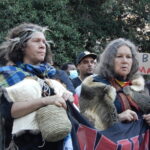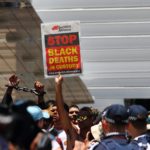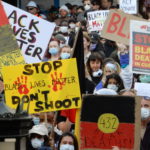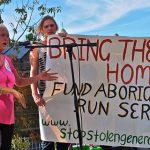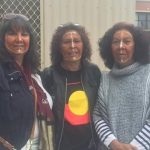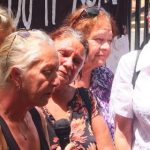Australia Has a Black History: An Interview With Gadigal Elder Rhonda Dixon-Grovenor
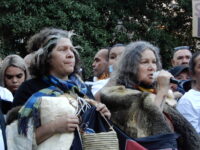
The Gadigal people are the traditional custodians of the area now known as the Sydney CBD. Prior to any event, demonstration or address taking place on that land, it’s protocol to pay respects to Gadigal elders past, present and emerging.
And Aunty Rhonda Dixon-Grovenor is a Gadigal, Bidjigal, Yuin elder.
As the NSW police sought to shut down the Stop All Black Deaths in Custody protest on 5 June, Aunty Rhonda appeared outside the NSW Supreme Court and told the press, “We have a right to gather on our country. We have a right to speak, and a right to express ourselves as human beings.”
The life-long activist added that the Gadigal people “have lost so much”. “We were the first people to be affected with colonisation. The first stolen generation. And we will stand up for our rights as equal human beings.”
After the court ruled the protest could go ahead on the following day, Aunty Rhonda addressed the tens of thousands gathered at Warrang-Sydney’s Belmore Park. And as she did so, she stood beside her daughter, artist Nadeena Dixon, and before the smouldering of the smoking ceremony.
Ongoing stolen generations
Aunty Rhonda is currently leading a racial vilification action against Sunrise host Samantha Armytage and commentator Prue MacSween over a March 2018 television segment, which saw a panel of Anglo Australians suggest that another stolen generation might be needed.
Eight complainants are set to take action in the Federal Court after negotiations over an initial complaint filed with the Australian Human Rights Commission broke down. The group asserts that the incident was a “devastating display of racism” that was “shameful” and “profoundly hurtful”.
The Channel 7 panellists have also been criticised for their lack of knowledge around the high rates of Aboriginal and Torres Strait Islander children that continue to be removed from their families to this day. Many refer to this as the ongoing stolen generations.
The 2020 Productivity Commission report outlines that in June 2019, there were 17,979 First Nations children in out-of-home care. This accounted for 40 percent of all children in care in this country, however Indigenous kids make up less than 6 percent of the overall child population.
A freedom fighter
Aunty Rhonda is the daughter of prominent Aboriginal rights leader Dr Charles “Chicka” Dixon. Inspired by civil rights activist Jack Patten, who was an organiser of the 1938 Day of Mourning, Dr Dixon dedicated his life to fighting for his people’s rights under an oppressive settler colonial state.
Present at the 1965 Freedom Rides alongside Charles Perkins, Dr Dixon was also a key player in seeing the establishment of the Aboriginal Tent Embassy, as well as the first Aboriginal Legal Service in Redfern.
Sydney Criminal Lawyers spoke to Aunty Rhonda about the Gadigal people in Warrang-Sydney, the importance of pursuing the Sunrise racial vilification matter, and the conversations she makes clear need to happen before there can be proper healing on this continent.
Firstly, you spoke at Belmore Park on 6 June as part of the Stop All Black Deaths in Custody rally. That demonstration was huge. Many remarked that they hadn’t seen such a turnout on this matter since the 1980s.
Aunty Rhonda, what did you think of the rally?
The speakers were getting the message across about black deaths in custody and the brutality to Aboriginal people in custody, which was so important.
They spoke about the over 430 deaths in custody and how not one police officer has been convicted.
Everyone was on the same page. Even though they’ve all got differences of opinion, they were on the same trajectory. It was a strong protest and it was peaceful.
The rally was held in Warrang-Sydney, which is Gadigal land. You spoke as a representative of the Gadigal people.
What sort of area around what’s now referred to as Sydney is Gadigal land?
The Gadigal area is part of the 29 clan areas around Sydney.
The documentation of the clan areas was done by white fellas. The way they put the boundaries doesn’t properly represent us, because our people were nomadic and travelled around Sydney coastal and inland areas.
Because of the changing of the season, we would follow the mullet, the yam season, when the whales migrate and the right time to collect eels.
Our people were nomadic following the seasons, camping along the rivers – the Georges River, the Cooks River.
Our great grandmother, Jenny Locke, was in the institution that was at the Domain. And she used to walk from there, through Centennial Park and over to La Perouse to visit our people.
So, the Domain – Djarrbarrgalli – is a very sacred area for our people. Our people used to gather there for corroborees. They used to host all the different types of people who would come in for them.
We’ve had over 60,000 years of our ancestors living in the Sydney and La Perouse area. We’ve also got connections out in Dharug country – ancestral connections.
And our ancestor King Cobi was a resistance fighter with Pemulwuy.
A smoking ceremony took place at Belmore Park, before the speakers spoke at the Black Lives Matter protest. What’s the significance of the smoking ceremony?
The significance of the smoking ceremony is to bless what’s happening with the people around the area.
It’s to give blessing to the ancestors to keep everyone safe from wherever they came from, while they’re there, and safe on their return home.
The smoke is to cleanse everyone.
You’re about to lead a racial vilification action against Samantha Armytage and Prue MacSween because they suggested on television that another stolen generation might be a good idea. Why is it important to pursue this matter?
It’s important to pursue this matter because those suggestions by Prue and Samantha were that Aboriginal children would be better off with white people, and that’s part of the ongoing stolen generation. This has been going on since colonisation.
The removal of children was because of the white assimilation policy. The Protection Act was all about removing fair-skinned children, putting them in institutions and training them up to be slaves, so they could be sent out into white people’s homes and farms.
Boys were made to go and work out on the farms. Girls were made to work in the houses.
My grandmother was sent from La Perouse over to the North Shore to clean houses for the rich white people. Our people never used to go over to that side of the bridge very much.
And my mother was a cleaner. So, I was actually a part of that slave trade. Under the Protection Act, Aboriginal people were taken to work for white people, as maids, servants and ranch hands – that sort of thing.
It was about teaching Aboriginal people to be like white people, so they could assimilate. It was to keep them away from their darker skinned families. It was all about assimilation.
As you’ve just mentioned, the stolen generation is ongoing. What’s currently happening with the forced removals of Indigenous kids from their families in Australia? And what impact is it having?
We are only 3 percent of the population, but the rate of the removal of Aboriginal children is high considering how small our population is.
Research shows that people who are put into institutions and foster care are more likely to be incarcerated as adults.
Rather than split families up and traumatise children, there should be programs to help Aboriginal people.
Because of intergenerational trauma a lot of Aboriginal people have mental health issues and drug and alcohol issues.
So, there needs to be a really strong program put into place to educate Aboriginal people about anger management, emotional intelligence and positive parenting.
When a lot of our children were taken and incarcerated, there was a lot of cruelty, and abuse, both sexual and physical. That has come down through the generations.
My grandfather, Jimmy Dixon, was put in Kinchela Boys Home. And because of that, those children didn’t have their parents as role models to teach them how to interact. That means when they have children, they don’t have those role modelling skills. So, it comes down the generations.
That’s why I went to study my masters on intergenerational trauma and recovery Aboriginal studies under Professor Judy Atkinson. I wanted to break that cycle. And I wanted to learn skills that would benefit me in my life.
I’m now doing a masters on Gadigal protocol, while working and studying on Gadigal land.
I went because my grandfather said, “The white fella has brought all this trauma, violence and alcohol to our people. They have pushed us back, taken all our land, our culture and stolen our children. Now, it is time for them to help us get better.”
Our knowledge, our culture and our spirituality, our smoking ceremonies, and our going back out into the bush and learning about all our bush foods, and also bringing in positive psychology and positive parenting skills – that’s what should be out there.
We know the answer to these things. But, when we speak, the white fellas don’t want to hear us.
Your father was prominent Aboriginal rights leader Dr Charles “Chicka” Dixon. What were his most significant achievements? And what’s his legacy today?
He was a freedom fighter. He first heard Jack Patten speak on his 18th birthday. Patten said, “Stand up for the rights of your people.” And that put my father on his trajectory – that political journey.
He was a wharfie. And his father, Jim Dixon, was a wharfie before him. Dad always attributed his days of working on the wharfs to having learnt about politics, strategic moves and public speaking. And we still have strong connections with the MUA.
So, my father was instrumental in lobbying for the 67 Referendum for Aboriginal people to be acknowledged and to get the vote.
In ‘72, every Sunday, he’d train these young fellas in politics. They were Gary Foley, Paul Coe, Michael Anderson and Sol Bellear. He trained all them in strategic moves and public speaking. That was when he suggested that they set up the Aboriginal Tent Embassy.
He also took a delegation of Aboriginal people over to China. He went over there to study how they were developing their industries and to bring those ideas back for Aboriginal people.
My father was also the first to get an Aboriginal scholarship to travel overseas. Gough Whitlam was instrumental in helping him get that.
So, he went to America and he studied the African American businesses and visited the Native American settlements and spoke to them about the treaties.
When he came back, he helped set up the Aboriginal Medical Service and the Aboriginal Legal Service. The first services were set up in Sydney and then they branched out all over Australia.
And John Mundine credited him to be the first Aboriginal person to promote Aboriginal art overseas.
Dad fought for justice, against the oppression of Aboriginal people and the right to maintain our connection to country.
If you look at the United Nations Declaration on the Rights of Indigenous Peoples it says on page 4:
“Welcoming the fact that Indigenous peoples are organising themselves for political, economic, social and cultural enhancement and in order to bring to an end all forms of discrimination and oppression wherever they occur.”
Page 5 says:
“Recognising, in particular, the right of Indigenous families and communities to retain shared responsibility for the upbringing, training, education and well-being of their children, consistent with the rights of the child.”
And Article 7 says:
“Indigenous individuals have the rights to life, physical and mental integrity, liberty and security of person.”
I do share a saying of my father’s, which is:
“I believe that every woman is my sister. I believe that every man is my brother. I know that the land is my mother. If all the leaders of the world were to follow this, there would be no more wars. And above all, there would be no more starving children.”
That was his belief and his values. He was a very staunch outspoken man.
And lastly, Aunty Rhonda, as well as being a prominent activist, you’re a well-known performer, singer, actor and playwright.
How would you say your activism, and the cause of First Nations justice, has informed your creative pursuits?
Everything that we do as a family is political. We’re a political, cultural and artistic family. And it underpins everything that we do in our lives.
My daughter, Nadeena Dixon, is a prolific artist. And her art is always to do with our culture and our lineage.
Nadeena is a master weaver. She does artwork on hessian bags, because our people were given hessian bags in the mission days. The hessian bags were to collect the rations: flour, tea and sugar.
Dad said when he was a young fella down at the mission at Wallaga Lake, you could smell the mission manager’s lamb chops cooking. And what they used to do is throw the guts – the offal – out to the Koories, like they were dogs.
There are many stories like that. And these stories have got to be told.
It’s very important that Aboriginal people tell these stories and get them into the education system, because it’s absolutely surprising how much – or how little – Australian people know about the Aboriginal history of Australia.
This little black secret has been kept for a long time. Yes, Australia does have a black history. And Australia was taken and stolen from Aboriginal people. There was genocide, there was murder and there was smallpox.
Aboriginal people were given blankets with smallpox on them.
Until these truths are told, I don’t think Australia will be able to move forward together in peace.
It’s not a nice feeling for Aboriginal people to be treated with such brutality and disgust.
And until the truth is told and we’re all able to sit at the table together – listening to and respecting each other – I don’t think that things will ever be right.


